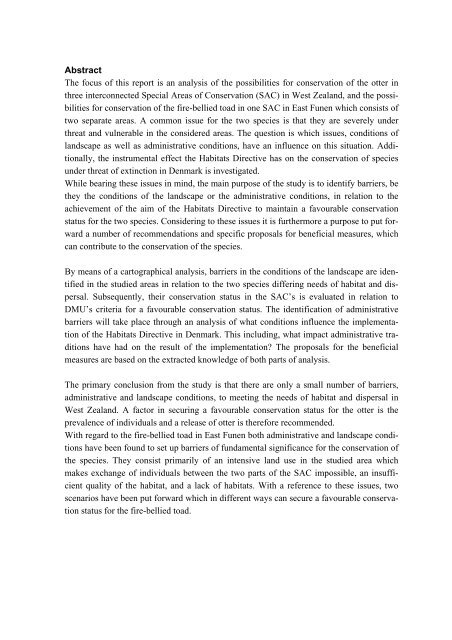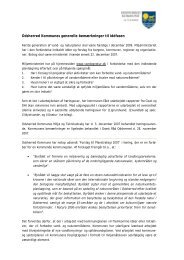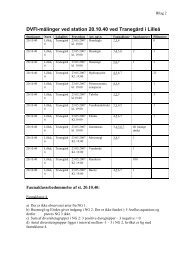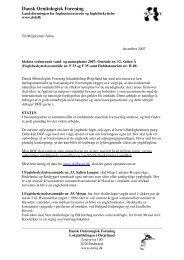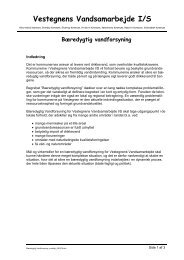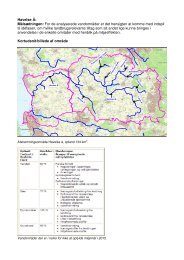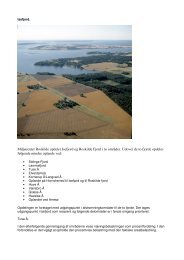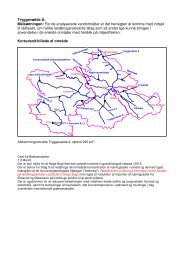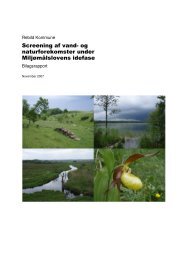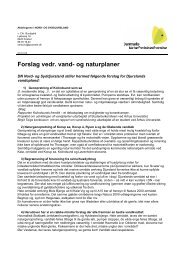- Page 1: BEVARELSE AF ODDER OG KLOKKEFRØ I
- Page 6 and 7: Indholdsfortegnelse 1 ARTSBEVARELSE
- Page 8 and 9: 8.6 Vurdering af klokkefrøens beva
- Page 10 and 11: ger sig over store afstande. Især,
- Page 12 and 13: pers. komm.). Danmarks Naturfrednin
- Page 14 and 15: 2 METODE Formålet med dette kapite
- Page 16 and 17: 2.2 Analysestrategi Figur 2.1 illus
- Page 18 and 19: lodsejere om deres syn på tiltagen
- Page 20 and 21: I forbindelse med Habitatdirektivet
- Page 22 and 23: Annita Svendsen: I slutningen af au
- Page 24 and 25: stere i en fragmenteret natur herun
- Page 26 and 27: March & Olsens handlingsteori er de
- Page 28 and 29: terfølgende er kortenes informatio
- Page 30 and 31: 3 POPULATIONER I ET FRAGMENTERET LA
- Page 32 and 33: menterne. Hvis en grænse er ”hå
- Page 34 and 35: En vigtig faktor for arters spredni
- Page 36 and 37: tiske drift kan dermed bevirke, at
- Page 38 and 39: Figur 3.2. Den dynamiske ligevægts
- Page 40 and 41: populationer øges ved en stigende
- Page 42 and 43: pulationen ikke er hurtigt aftagend
- Page 44 and 45: March & Olsen karakteriserer grundl
- Page 46 and 47: I Mazmanian & Sabatier (1989) defin
- Page 48 and 49: Adoption af uhåndterlige problemer
- Page 50 and 51: vende for, hvor højt en implemente
- Page 52 and 53: 5 KARTOGRAFISK ANALYSEMODEL I dette
- Page 54 and 55:
Redegørelse for den kartografiske
- Page 56 and 57:
sættelsen er der på de tematiske
- Page 58 and 59:
Metode til verificering af elemente
- Page 60 and 61:
6 ARTERNES HABITAT- OG SPREDNINGSKR
- Page 62 and 63:
Formering og opvækst: Han- og huno
- Page 64 and 65:
Udviklingen i odderpopulationen Af
- Page 66 and 67:
odder. De indsamlede ekskrementer i
- Page 68 and 69:
6.2 Klokkefrø (Bombina bombina) Un
- Page 70 and 71:
heder for formering, fouragering og
- Page 72 and 73:
I undersøgelsen har det dog været
- Page 74 and 75:
6.2.1 Opsummering af klokkefrøens
- Page 76 and 77:
Store Åmose - mellem Undløse Bro
- Page 78 and 79:
m fra vandløbet. Vandkvaliteten i
- Page 80 and 81:
Faunapassager og spredningsmulighed
- Page 82 and 83:
vis korridor mellem de to områder.
- Page 84 and 85:
På den baggrund må det formodes,
- Page 86 and 87:
På baggrund af de relativt uforsty
- Page 88 and 89:
områderne. (Byrnak, 2006, pers. ko
- Page 90 and 91:
Det varierede landskab byder på ma
- Page 92 and 93:
Sejerø Bugt Sejerø Bugt. Foto: Th
- Page 94 and 95:
imellem de tre lokaliteter. Herefte
- Page 96 and 97:
Eutrofieret vandhul på campingplad
- Page 98 and 99:
Vandhul etableret i forbindelse med
- Page 100 and 101:
Etableret vandhul ved Teglgårdshus
- Page 102 and 103:
Vandhullernes beliggenhed og landsk
- Page 104 and 105:
et betydeligt udbud af habitater, d
- Page 106 and 107:
8 GUNSTIG BEVARINGSSTATUS Formålet
- Page 108 and 109:
ternes bevaringsstatus først kan v
- Page 110 and 111:
Bestand: En lokalitet med forekomst
- Page 112 and 113:
På lokalt niveau skal der ifølge
- Page 114 and 115:
indenfor og mellem egnede habitater
- Page 116 and 117:
Kilde: Gengivet fra Søgaard, et al
- Page 118 and 119:
Ligeledes kræver kriteriet vedrør
- Page 120 and 121:
8.7 Opsummering Gennemgangen af Hab
- Page 122 and 123:
telse, normer og interesser, som ne
- Page 124 and 125:
Som en konsekvens af den indflydels
- Page 126 and 127:
Formålet med direktivet fremgår a
- Page 128 and 129:
lovgivning enten ved lov af Folketi
- Page 130 and 131:
venien og Slovakiet. (Kommissionen,
- Page 132 and 133:
Når Kommissionen har godkendt et m
- Page 134 and 135:
der er valgt sammenfaldende afgræn
- Page 136 and 137:
art mulighed for flere udpegninger.
- Page 138 and 139:
ikke i tvivl om, at Artsfredningsbe
- Page 140 and 141:
Opsummering Som der er redegjort fo
- Page 142 and 143:
Som der endvidere er redegjort for
- Page 144 and 145:
de billede er disse midler fuldstæ
- Page 146 and 147:
klokkefrøpopulationer. Forklaringe
- Page 148 and 149:
flikter omkring arealanvendelsen. I
- Page 150 and 151:
nedenstående boks er kriterierne l
- Page 152 and 153:
mangfoldighed, så odderen igen kan
- Page 154 and 155:
i form af ”Risiko for krydsende o
- Page 156 and 157:
Græsset på Tårup Campingplads er
- Page 158 and 159:
med, at spredningen foregår på ek
- Page 160 and 161:
En udsætning vurderes på den bagg
- Page 162 and 163:
Lokaliteten ved Klintholm er derved
- Page 164 and 165:
12 PERSPEKTIVERING I den afsluttend
- Page 166 and 167:
frivillig aftale om omlægning af d
- Page 168 and 169:
Caspersen, O. H. & Nellemann, V. 20
- Page 170 and 171:
Hanski, I. 2005: The shrinking worl
- Page 172 and 173:
Nielsen. A., (ed.) 2005: Institutio
- Page 174 and 175:
Søgaard, B. et al. 2003: Kriterier
- Page 176 and 177:
Lov nr. 9, 1992: Lov om naturbeskyt
- Page 178 and 179:
BILAG Bilag 1-6: Findes på den ved
- Page 180 and 181:
Bilag nr. 8: Verificering af kartog
- Page 182 and 183:
Undersøgelsesstation nr. 6: Gangbr
- Page 184 and 185:
Undersøgelsesstation nr. 10: Skarr
- Page 186 and 187:
Undersøgelsesstation nr. 16: Bro o
- Page 188 and 189:
Undersøgelsesstation nr. 21: Bro o
- Page 190 and 191:
Undersøgelsesstation nr. 27: Bro o
- Page 192 and 193:
Bilag nr. 9: Fredning af lokalitet
- Page 194 and 195:
Tabellen viser kriterierne for guns
- Page 196 and 197:
Bilag nr. 12: Besvarelse af henvend
- Page 198 and 199:
Bilag nr. 1: Referat af telefonsamt
- Page 200 and 201:
Bilag nr. 2: Transskriberet intervi
- Page 202 and 203:
løb, hvor der ligger søer tæt p
- Page 204 and 205:
saltvand. Man har snakket om, at od
- Page 206 and 207:
Den nordjyske odder spreder sig ned
- Page 208 and 209:
spærringer? Rørlægning på en ki
- Page 210 and 211:
Bilag nr. 3: Transskriberet intervi
- Page 212 and 213:
ver delt ud, og det er der også tv
- Page 214 and 215:
følgelig tidligere været én best
- Page 216 and 217:
klokkefrø, men de medarbejdere kom
- Page 218 and 219:
Hvordan har I fået landmændene ti
- Page 220 and 221:
Jeg vil sige, at der er brug for, a
- Page 222 and 223:
Har I nogen spredningsøkologiske b
- Page 224 and 225:
Bilag nr. 4: Transskriberet intervi
- Page 226 and 227:
Da vi fandt spor efter odder i 90
- Page 228 and 229:
I jeres handlingsplan skriver I, de
- Page 230 and 231:
enormt usikkert, så mange har alle
- Page 232 and 233:
ingeniørerne skal bare lære at t
- Page 234 and 235:
tigelse til at udpege det hele. For
- Page 236 and 237:
egentlig dårlig forvaltning, så v
- Page 238 and 239:
etragtning på tværs af medlemslan
- Page 240 and 241:
så kan overveje. I VVM-reglerne er
- Page 242 and 243:
der skal løfte den situation. Det
- Page 244 and 245:
tens bevaringsstatus. Men, hvordan
- Page 246 and 247:
arten for at beskytte den? Det er r
- Page 248 and 249:
1995, hvor medlemslandene skulle ha
- Page 250 and 251:
nu skal man udpege de områder, og
- Page 252 and 253:
for fravigelse, som der ikke var f
- Page 254 and 255:
løbene, så kunne du jo bare gå r
- Page 256 and 257:
hvilken art er det for. Det, de gjo
- Page 258 and 259:
jo ikke krav om aktive bevaringsfor
- Page 260 and 261:
Hvor stort skøn er der for et medl
- Page 262 and 263:
måtte jeg så give ham ret. Det va
- Page 264 and 265:
10-15 kg, og det får 21,4 kg. Er p
- Page 266:
Og så tror jeg, det er vigtigt, at


